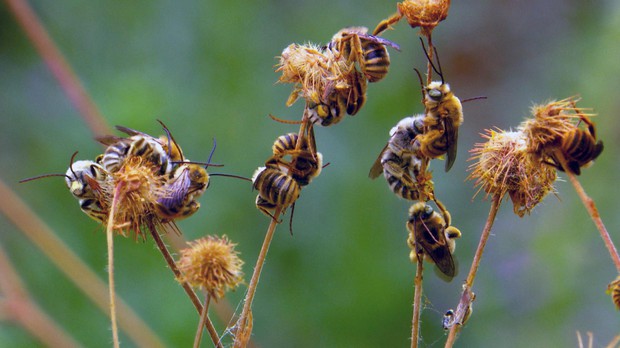
The Search Is On For Every Bee Species In Oregon
Listen
The European honey bee might suck up all the attention, but a true bee connoisseur will point you to the native species. From fuzzy bumble bees to glistening sweat bees and stately long horns, native bees are wild critters of almost endless variety.
They possess the kind of charm that attracts amateur insect lovers like wasps to a picnic — or in the case of a cool summer day, volunteers to the gardens of the Winter’s Hill Estate winery near Dundee, Oregon.
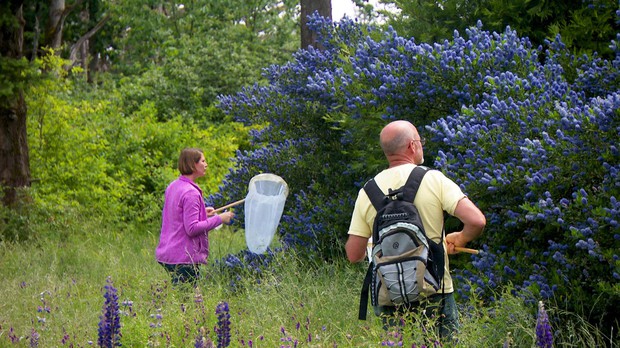
Michael O’Loughlin (right) leads the Yamhill County Oregon Bee Atlas team at Winter’s Hill Estate outside Dundee. CREDIT: MICHAEL BENDIXEN
“Let’s get out there and collect as many bees as possible, on as many plants as possible,” said master gardener Michael O’Loughlin to a dozen other volunteers before the group fanned out to the many flowering plants, nets swishing in search of buzzing targets.
These weren’t just any bee-ophytes: they’re on a statewide mission to survey every bee species in Oregon for the very first time.
“Our effort is to go around and to sample all the bees we can and figure out what species are in Yamhill County, and there’s other groups throughout the state that’re doing the other counties,” O’Loughlin said.
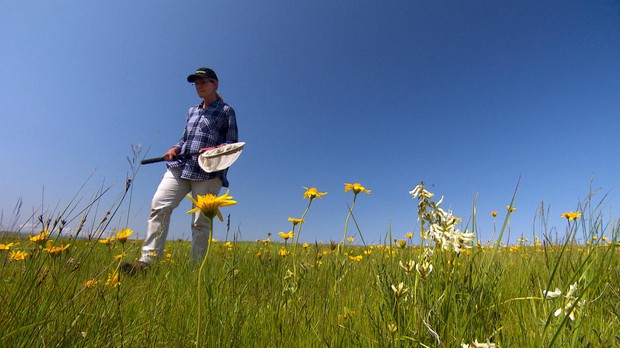
Oregon State University invertebrate ecologist Sandy Debano collects bees for the Oregon Bee Atlas on the Zumwalt Prairie in northeastern Oregon. CREDIT: NICK FISHER
Experts believe around 500 species might live in the state, but no one knows for sure. Which is a problem, because we could be losing bee species at an alarming rate.
In 2013, a massive bee-kill in a Wilsonville shopping center made national news. An estimated 50,000 bumble bees died from exposure to an over-the-counter insecticide called Safari, littering the parking lot in what many called the biggest die-off in modern history.
But why was the die off such a big deal?
Because, alongside honey bees, bumblebees and other native bees are essential to the pollination of many of the crops that make up Oregon’s $6 billion agricultural industry. In response to the die-off and one that followed shortly after, the Oregon Legislature passed a bill in 2014 that declared a pollinator emergency.
“We became the only state in the whole country that has a funded mandate to put together a strategic health plan for pollinators,” said Sarah Kincaid, an entomologist with the Oregon Department of Agriculture’s Insect Pest Prevention and Management Program.
To fulfill that mandate, Kincaid’s department teamed up with the Oregon State University Extension Service and the Oregon Department of Forestry in 2017 to create the Oregon Bee Project. Their mission is to expand our understanding of local bees, to increase their habitat through working with farmers and gardeners (beginning with a Flagship Farm program), and to protect them from pesticide exposure and disease, in part by training pesticide applicators.
“Our long-term goal is really to assess whether or not bee species here in Oregon are declining or whether or not they’re stable,” Kincaid said.
To do that, first they need to figure out exactly what species call Oregon home — something the state has never had the resources to do. So the Bee Project turned to volunteers. Now anyone can sign up with a local team as part of what organizers are calling the Oregon Bee Atlas.
Which brings us back to the team in Yamhill County.
“Here comes a longhorn bee,” O’Loughlin said, as he took aim and swung his net, detonating a small explosion of pollen.
The volunteers spent an hour netting bees, recording the plants they were found on, and preserving just one of each in boxes, just as other teams are doing across the state.
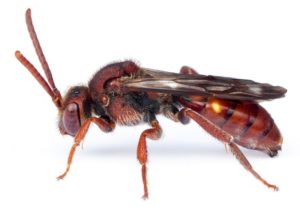
The cleptoparasitic nomada “cuckoo bee”. CREDIT: OREGON DEPARTMENT OF AGRICULTURE
The diversity of bees from just this one winery was mind-boggling. There were glistening-green metallic sweat bees, bright-red cleptoparasitic nomad bees, small black lasioglossum bees that look like flying ants, and a spectrum of fuzzy bumble bees.
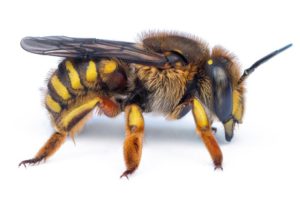
Anthidium wool carder bee
CREDIT: OREGON DEPARTMENT OF AGRICULTURE
“You start to realize that, wow, all these years that I’ve been seeing bees, I didn’t know they were bees. I thought they would be flies and they were ants,” O’Loughlin said. “Which just makes you wonder, what have I been missing?”
But collecting the bees is only the first step. Next, they have to figure out what species they’ve found. That might seem easy when you’re trying to tell a honey bee from a bumblebee, but try telling one of the dozen species of bumblebee from another, to say nothing of the hundreds of other bee species and creatures like flies and beetles that have evolved to look like bees, and chances are you need an expert.
And bee experts are something of an endangered species themselves.
So the Bee Atlas decided to train their own. In July, O’Loughlin and other budding bee lovers gathered at Oregon State University for the very first Oregon Bee School, a week-long course on identifying native bees, at least to the genus level, taught by bee taxonomist Lincoln Best.
The mornings were made up of lectures, breaking bees down by the major groups. Then afternoons were spent squinting at specimens under microscopes and then trying to work their way through binder-sized identification keys that read like a Choose-your-own-bee-adventure book. Granted, one that’s written with scientific jargon that may as well be a foreign language.
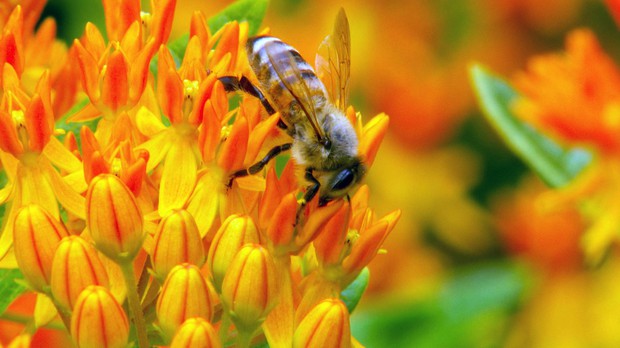
After learning about the incredible diversity of native bee species, the European honey bee just doesn’t seem as special anymore, don’t you think?
Photo: TODD SONFLIETH/OPB
For instance, little more than a half hour passed on the first day before O’Loughlin’s tablemate, Toni Stephan, got stuck. “’Equal to half or less than half of the distance separating the lateral oscellus from the inner margin of the eye,’” she read, moving her eyes from her key to the mystery bumblebee beneath her scope.
“Wow,” is all O’Loughlin had to say, his eyes reflecting back her exasperation.
“It hasn’t taken us anywhere yet: my god,” concluded Stephan, as her head fell into her hands.
Even though it’s painstaking work, O’Loughlin said the endless diversity and discovery are a reward in themselves.
“Looking at them through a microscope opens up a whole different world. You may think that you’re looking at, say, a small black bee, but get it under a microscope, and you’re seeing all sorts of colors: shiny colors, different hair colors, golden hairs, stuff that you would never see with the naked eye. Especially when you’re 56 years old, you definitely would not see that.”
The idea is that, if the Oregon Bee Atlas can chart where various bee species live and what plants they pollinate, we can better protect and even cultivate them.
Although, as O’Loughlin joked, they’re all secretly hoping to be the one who discovers a new species: “Yeah, that’s great, but it’s not going to be named after you, so just don’t even ask that question.”
In the span of just a few years, a deadly disaster in a shopping center parking lot has blossomed into the dream of finding new life. So the next time you stop to smell the flowers, pause to see what else is there smelling them with you. It might just move the needle of science one bee further.
Related Stories:

Bonneville Power Administration could be losing money because of contract handling, federal audit says
The McNary Dam in Umatilla, Oregon. The Bonneville Power Administration’s Fish and Wildlife program works to lessen the impact of Columbia River Basin dams on wildlife. (Credit: Pacific Northwest National

More than $30 million in restoration projects taking place in North-Central Idaho
This photo from August 2020 features Rocky Ridge Lake, a popular hiking and camping site in the Nez Perce-Clearwater National Forests. (Credit: Lauren Paterson / NWPB) Watch Listen (Runtime 1:03)
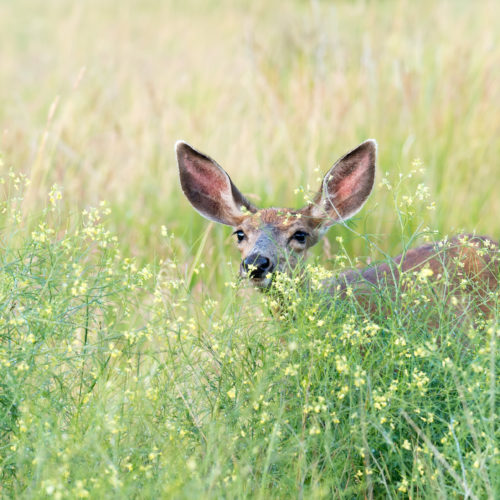
Fatal deer disease found in Washington for the first time
Mule deer in tall grasses and forbs, Iwetemlaykin Heritage Site, Wallowa Valley, Oregon. (Credit: Leon Werdinger / Alamy Stock Photo) watch Listen (Runtime 0:59) Read A fatal disease for deer















